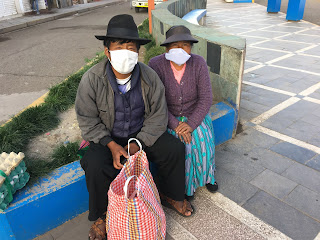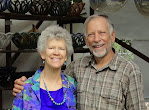Due to the Pandemic, we stayed on Taquile for five months in 2020, January to June, under Peruvian lockdown after Mid-March, in safety, and experiencing Taquile culture in the absence of tourism.
Here's the Short Version:
Sam and I were “stuck” on Taquile an extra two months this year, with no tourists, after the March 16 quarantine declaration. It was actually pretty cool and safe, with no nearby cases for quite awhile, then just a few in all of Puno province. Under the Peruvian stay-home orders, we Taquileños simply considered the shoreline as the walls of our “house,” and lived as a community. When Sam and I finally got our tickets to repatriate, our journey was expensive and arduous (overland from Taquile to Lima), but we got home to liberate our dedicated house sitters here in Colorado and in time to plant a garden.
Here's the Long Version:
When the Peruvian Government declares the emergency and initiates quarantine lockdown on March 16, we still have a couple of weeks to go before our scheduled flight home. I rescheduled the LATAM flight from Juliaca to Lima from April 3 to the April 7 date of our US flight. Our goddaughter and her family live in a fairly crowded neighborhood on a hill in the capital city of Lima, which is starting to report coronavirus cases so we will skip our few days visit with them this year.
So I’m in no big hurry to leave. Except that our Peruvian visas expire on April 9.
So we gather up our courage and take the boat to Puno with Silvano and Ruperta on March 30. We need to get money out of the ATM, and to extend our visas at the Peruvian Consulate. It’s also a supply trip: rice, oil, flour, salt, and treats: bread, cheese, chicken, avocados, olive oil. We have no trouble getting our money, but the Consulate has been closed for two weeks. We will try to renew it online.
We dress as Taquileños, Sam with a vest over his traditional shirt, me with three skirts and a chuko over my head. We wear masks over our nose and mouth, as does everyone in Puno. Military or Police are on every major street corner making sure everyone is wearing a mask and keeping distance. In the line at the bank, they call out “dos metros, dos metros” to keep the line spacing at two meters between each person.
On the boat, we enjoy a nice conversation with the Taquile woman who brings produce to Taquile every week. We have a very official letter from the authorities on Taquile Island, explaining that we have been on Taquile since January 12 and that we are helping the Taquileños. When the boat docks, our captain, Elias, tells us to stay in our seats; we will be the last ones off. Then he urges us to close the curtains, warning that the press is there! Two coastguard officers come on the boat with their machine guns and wearing masks (as we all are). They photograph our letter and our passports and tell us to be careful. The press is gone by the time we get off the boat, but later we see a video from the local television station. In the interview with our produce lady, when asked if there are any tourists on Taquile, she tells them no. She is accurate, actually, as we are not tourists on Taquile, but family members.
Again when we leave Puno the next day, the coastguard officers photograph our documents again, and wish us a pleasant boat ride to return to Taquile. Machine guns and all.
We hear rumors of foreigners being arrested and removed from the nearby peninsula; we can’t imagine where they are being taken, but we don’t leave the island again until we are on our way back to Colorado, two months later. I begin to wear traditional Taquile clothing every day, to blend in. From a distance I look like every other Taquile woman if you don’t notice my glasses. The Taquileños like this and compliment me.
We register with the U.S. Embassy’s Smart Traveler Enrollment Program (STEP) and begin receiving notifications about repatriation flights. We also learn that the Peruvian Government has automatically extended all foreigners’ visas until 45 days after the quarantine ends, thus solving that problem. And the US Government extended the deadline for filing taxes to July. So now we are truly happy to stay where we are.
A non-profit organization, Warrior Angels Rescue (WAR), looks like our best way to get home. They run on donations, and we will be happy to contribute. They have one flight all scheduled for early May, and are planning another which would fly us from Arequipa and we could avoid the longest of overland travel. Suddenly their flight is blocked by the US government from landing in the United States. Travelers waiting at the airport, passports already stamped, had to return to wherever they were staying. The US Embassy offers the only official flight on Easter Airlines for $2050 per person from Lima to Miami, a flight that cost $200-$400 before the border closure due to COVID-19. We consider this high price as price-gouging, a result of some sort of corruption and refuse to participate. Other flights are also announced, still overpriced at $1300. So we stay on Taquile and help out as best we can. Future blog posts will feature our extended stay on Taquile.
We join several social media groups of people stuck in Peru and follow them on our cell phones on Taquile. Most people are much worse off than we were. We made the following video for WAR to use in their fundraising.
The weeks keep passing by, and some slightly more reasonable flights are offered. One day, Saturday, May 30, we see a flight for $1000 each that includes luggage. We jump on it; make our reservations immediately. The confirmation comes through while we are playing volleyball high above the plaza and I duck out of the game to make our payments. When we tell our teams that we will be leaving for the US within a few days, they are surprised and shocked.
Getting home is arduous and long. Here it is in 12 steps:
1. Monday. A two mile hike to the boat with luggage (lots of help) down the famous 500 steps.
2. Three hour boat ride to Puno; last minute purchases; overnight in Taquile albergue.
3. Tuesday. Five hour ride in private van from Puno to Arequipa; meet our travel partner in her hospedaje, rest and await our 8pm transportation.
4. Seventeen hour overnight combi ride to Lima; carsickness.
5. Wednesday. Carried luggage two blocks to AirBnB since security measures closed street; buy food at convenience store, cook, eat and sleep overnight.
6. Thursday. Carried luggage back to meet taxi at 5:00am for 1/4 mile ride to meet busses for shuttle to airport; two hours waiting on bus (bathroom available).
7. Check-in sitting in plastic chairs under a tent at the Peruvian Air Force Terminal (commercial airport closed). Bring our own food and water both for waiting and for the flight. Bus across tarmac to airplane.
9. Friday. Flight to Houston leaving at 6:30am.
10. Flight Houston to Denver.
11. Beautiful private car drive over the Rockies; 5 hours to Grand Junction and our car.
12. Drive ourselves from Grand Junction 1 1/2 hours to Paonia and HOME.
 |
| A drive through Glenwood Canyon |
 |
| HOME |
























































